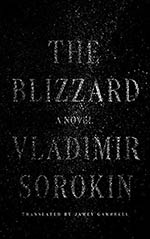
![]() charlesdee
charlesdee
1/31/2016
![]()
Whenever I review of foreign language work of speculative fiction, I find myself including a statement reflecting my certainty that readers of the work in its original language - Russian, Spanish, Estonian, whatever - have a fuller experience of its subtleties, humor, and imagery than I. That statement usually comes towards the end of the review, but with Vladimir Sorokin'sThe Blizzard, I have decided to put it up front. I feel certain that his Russian readers have a - well, as I said.
It helps to learn that Russian readers, by the time reach adulthood, have received a steady diet of "lost in the snow" narratives. The motif appears in fiction, verse, and folklore, and the stories almost always end poorly for their protagonists.The Blizzardopens with Dr. Garin, who is desperate to find transportation for himself and his serum to the plague-struck village of Delgoye, learning that snow has shut down the railway. It's a set-up that will prompt Russian readers to think, "Here we go again."
The forested, rural setting seems nineteenth century, and the frantic Dr. Garin, with his pince-nez and mustache, steps out of a Chekov story. That atmosphere continues when Dr. Garin learns that Crouper, the peasant who handles local bread deliveries, may have horses and a sleigh available. He approaches the man, who does indeed have horse. He has fifty of them. This is a reasonable number, since they are the size of partridges, and they propel his sleigh by running inside a drum. The doctor convinces Crouper to undertake the journey, which in normal circumstances would take only a few hours. The village will be saved from what we learn about this time is an outbreak of zombies caused by a virus brought back from Columbia. The dead are tunneling through the village, breaking into homes, and infecting the living. Dr. Garin does not approve of foreign travel.
Sorokin is one of the most popular contemporary novelists in Russia. His work employs fantastic elements in narratives that range from traditional science fiction to the sort of weird environment he builds in The Blizzard. It is never clear if he has set this tale in an alternate nineteenth century or some future that has devolved into a combination of new technology crippled by a collapsed infrastructure. (Thanks to another review, I learned that there are internal clues that place the story in our own present day.) One development running throughout the story is the twin phenomena of biological miniaturization and gigantism. Crouper's tiny horses are distantly related to horses the size of small apartment blocks. These are used to haul trains that no longer have a power source. On their journey, Garin and Crouper take refuge in the home of a miller the size of a samovar. Garin has a sexual encounter with his full-sized and delectable wife. One of the men's many road accidents occurs when a runner of their sleigh crashes into and breaks off in the nostril of a dead giant.
The details of all this are enjoyable and expertly drawn, even if their import remains vague. Dr. Garin becomes increasingly unsympathetic, his humanitarian zeal a cover for his temper, condescension, and poor impulse control. My sympathies all went to Crouper and his tender concern for his hard-working horses. You don't have to be Russian to guess that this trip into the snow will end badly. But again I find myself wondering if a Russian reader finds all this more than a mildly entertaining curiosity?